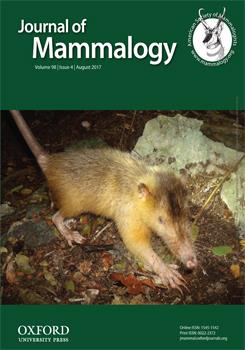Two subspecies of Andinomys edax are currently recognized. Andinomys e. edax ranges from southern Perú to northernmost northwestern Argentina and A. e. lineicaudatus is mainly distributed in southern northwestern Argentina. However, some workers have recognized both taxa as distinct species, stating that A. edax is restricted to Puna and Prepuna habitats between 2,000 and 4,800 m elevation, whereas A. lineicaudatus occurs in Yungas forest below 2,500 m. We assessed the taxonomic status of both forms through an integrative approach including morphological (discrete skin and skull characters), morphometric (univariate and multivariate), geographicenvironmental niche modeling (Mahalanobis Typicalities), and molecular (Bayesian analysis of cytochrome-b gene sequences) analyses. We did not find characters that consistently differentiated skins and skulls of the 2 forms. The morphometric analysis indicated that lineicaudatus is, on average, larger than edax for some measurements, but only 2 (alveolar width and occipital condyle width) differed significantly between forms. No group of specimens was clearly segregated in the PCA morphospace. Distribution models obtained separately for each taxon do not offer a better fit to the known distribution than models based on the combined data sets. We documented coincident environmental variables as relevant in the model building of edax and lineicaudatus, noting some segregation in elevation, but similar habitat suitability for the remainder of the environmental variables. The geographic continuity between niche models of edax and lineicaudatus was clear but specimens morphologically assignable to each of the nominal forms were not found in areas of overlap. The phylogenetic analyses recovered a polytomy of 4 allopatric and genetically divergent clades, which also failed to support the taxonomic hypothesis of 2 species. Based on all available evidence, we conclude that Andinomys consists of a single species. Nevertheless, observed genetic divergences among clades and their geographic distribution indicate that past events probably fragmented populations of A. edax.
How to translate text using browser tools
26 June 2017
Integration of morphological, ecological, and genetic evidence suggests that the genus Andinomys (Rodentia, Cricetidae) is monospecific
J. Pablo Jayat,
Guillermo D'Elía,
Ricardo Torres,
Silvia E. Pacheco,
Pablo E. Ortiz,
Jorge Salazar-Bravo,
Bruce D. Patterson
ACCESS THE FULL ARTICLE

Journal of Mammalogy
Vol. 98 • No. 4
August 2017
Vol. 98 • No. 4
August 2017
Andean rat
central Andes
Muridae
Sigmodontinae
South America
species limits
type locality




